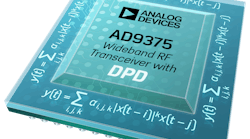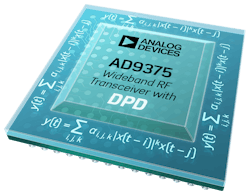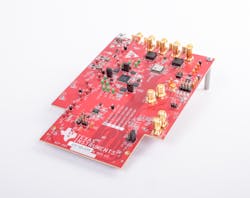The spirit of the 2017 IEEE International Microwave Symposium (IMS) is very much dominated by the RF/microwave industry’s near obsession with the coming Fifth Generation (5G) of wireless communications technology, with more than half of the exhibitors touting some recent development aimed at 5G. This is especially true in the world of integrated circuits (ICs), where one of the most elegant solutions for builders of small base stations and microcells can be found under the Analog Devices banner (www.analog.com) at booth No. 1032: the AD9375 RadioVerse transceiver. This single IC, supplied in a BGA package, may be as representative of how the state of integrated-circuit (IC) technology is enabling the once-unimaginable wireless performance levels being promised by 5G network developers. With a frequency range of 0.3 to 6.0 GHz, the IC contains two differential transmitters, two differential receivers, an observation receiver, a sniffer receiver, and a full on-chip digital-predistortion (DPD) solution for linearizing power amplifiers. It is a true system on a chip, and with power consumption of only 5 W. Representatives from Analog Devices will be on hand to explain the benefits and to show off a low-power evaluation circuit.
Among the other IC suppliers making news at the 2017 IMS, Texas Instruments will show a high-speed digitizer of interest to both commercial and military system designers: the ADC12DJ3200 RF-sampling analog-to-digital converter (ADC). Capable of sampling input signals from DC to 10 GHz, it operates with one or two channels, with sampling rates to 6.4 GSamples/s in single-channel mode and to 3.2 GSamples/s per channel in dual-channel mode. Visitors to booth No. 1618 can see the ADC mounted on a commercial evaluation board.
This RF ADC samples input signals at rates to 6.4 GSamples/s for direct sampling of signals to 10 GHz. (Courtesy of Texas Instruments)
The benefits of these new, high-performance ICs can be seen throughout the show floor, especially with the unveiling of the R&S SMA100B signal generator by Rohde & Schwarz at booth No. 1348. It was developed with the close cooperation of chipmakers Analog Devices and uses that company’s data converters. The analog signal generator sets new performance levels, with typically low phase noise of –152 dBc/Hz offset 20 kHz from a 1-GHz carrier. Ron Goga, test director of high-speed analog-to-digital converters (ADCs) for Analog Devices, said: “The close cooperation between our two companies and the timely release of the R&S SMA100B with extremely pure analog RF signals up to 20 GHz coincides with the release of Analog Devices’ new RF series of converters, which includes the new AD9208 dual 3-Gsampls/s 14-b ADC and AD9172 dual 12-Gsamples/s 16-b DAC. The state-of-the-art performance of the R&S SMA100B allows us to continue to showcase our RF data converters in the best possible light.”



